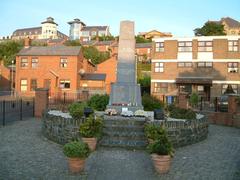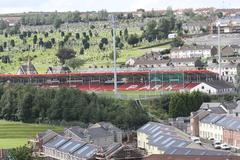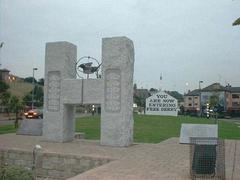Londonderry and Enniskillen Railway: Visiting Hours, Tickets, and Historical Sites in Derry
Date: 04/07/2025
Introduction
The Londonderry and Enniskillen Railway (L&ER) is a cornerstone of Northern Ireland’s industrial and cultural history. Connecting Londonderry (Derry) to Enniskillen from its inception in 1845 until its closure in 1965, the railway shaped the economic, social, and physical fabric of northwest Ireland. Today, its legacy endures through preserved infrastructure, museums, interpretive trails, and special events that invite visitors to explore Derry’s railway heritage (Grace’s Guide; Railscot).
This guide offers a comprehensive overview of the L&ER’s history, practical visitor information—including visiting hours, ticketing, accessibility, and tours—and highlights key heritage sites and nearby attractions. Whether you are a railway enthusiast, a history buff, or a curious traveler, use this resource to plan an engaging journey through Derry’s railway past.
Table of Contents
- Historical Background
- Visiting the L&ER Heritage Today
- Visitor Information
- Nearby Attractions and Travel
- Frequently Asked Questions (FAQ)
- Additional Resources and References
Historical Background
Origins and Early Development (1845–1860)
The L&ER was incorporated in 1845 to connect Derry with Enniskillen, linking northwest Ireland to major markets and fostering regional development (Grace’s Guide). Construction faced formidable engineering challenges, with the first section opening in 1852 and full completion by 1859. The line, built to the Irish standard gauge, quickly revolutionized transport in the area, offering efficient passage for both people and goods.
Expansion and the Great Northern Railway Era (1860–1950s)
In 1862, the L&ER entered a lease with the Dundalk and Enniskillen Railway, increasing integration and operational efficiency (Donegal Railway Heritage). The line expanded through branch connections to coastal towns such as Bundoran and Ballyshannon, promoting economic growth and social connectivity.
In 1876, L&ER became part of the Great Northern Railway (Ireland) [GNR(I)], supporting Derry’s thriving industries—particularly textiles and shirt-making—by providing vital freight and passenger services (Irish Archives Resource).
Engineering Achievements
The L&ER overcame geographical obstacles—rivers, boglands, and hilly terrain—through impressive feats such as embankments and bridges across the River Foyle. Substantial station buildings, goods sheds, and maintenance depots defined major stops like Derry, Strabane, and Enniskillen. The Fintona horse-drawn tramway, a unique branch, added to the route’s historical charm (wiki2.org).
Social and Economic Impact
The railway transformed Derry and its hinterland, providing reliable transport for workers, agricultural produce, and manufactured goods. It underpinned tourism to scenic locations and supported vibrant railway communities (RTÉ Archives). Government initiatives such as the Congested Districts Act further extended its reach to rural areas (Donegal Railway Heritage).
Decline and Closure (1950s–1965)
From the 1950s, increased road transport, shifting economic patterns, and dwindling passenger numbers led to systematic closures. The Bundoran branch closed in 1958, and the Derry–Strabane section followed in 1965 (Donegal Railway Heritage). While services ended, the railway’s legacy continues through preservation and community memory.
Visiting the L&ER Heritage Today
Museums and Heritage Centres
- Donegal Railway Heritage Centre (Donegal Town): Open Tuesday–Saturday, 10:00 AM–4:00 PM; features interactive displays, restored vehicles, and exhibits on the L&ER and regional railways. Admission: ~€5 for adults, with concessions (Donegal Railway Heritage).
- Tower Museum (Derry): Open daily, 10:00 AM–5:00 PM. Admission: £5–£7, with discounts available. Exhibits include the L&ER’s role in Derry’s history (lovetovisitireland.com).
- Ulster Folk and Transport Museum (Cultra): Open daily, featuring railway collections including the Fintona horse tram (wiki2.org).
Key Historical Sites in Derry
- Waterside Station: The current terminus for the Belfast–Derry line, open daily from 6:00 AM–11:00 PM. Restored in 2019, it blends historical architecture with modern amenities (Disused Stations).
- Former Foyle Road Station Site: Now repurposed, but still a landmark in the city’s geography (Disused Stations).
- Railway Bridges and Embankments: Remnants along the River Foyle, with interpretive signage and photographic opportunities.
Guided Tours and Special Events
- Heritage Walking Tours: Offered April–October, focusing on railway sites, bridges, and industrial landmarks. Booking via Visit Derry Information Centre is advised (Visit Derry Information Centre).
- Special Rail Events: Heritage rail journeys and commemorative events coincide with festivals—see Visit Derry or local listings for details (Trip101).
Walking and Cycling Trails
- Sections of the former railway have been converted into riverside walkways and greenways, open year-round from dawn to dusk. These scenic routes feature interpretive panels and are generally free to access (discovernorthernireland.com).
Visitor Information
Location and Accessibility
Derry is well-connected by rail (via Waterside Station), road, and bus to Belfast and other cities. The Visit Derry Information Centre in the city center provides maps, tour information, and local insights (Visit Derry Information Centre).
Visiting Hours and Ticketing
- Waterside Station: 6:00 AM–11:00 PM daily; ticket offices 7:00 AM–9:00 PM (Translink Railway History).
- Museum Hours: Typically 10:00 AM–5:00 PM; check individual websites for seasonal hours.
- Tour Tickets: £8–£15, available online or at the Visit Derry Information Centre (Visit Derry Information Centre).
- Trail Access: Free and open during daylight hours.
Accessibility Details
Most heritage museums and walking trails are wheelchair accessible. Some outdoor sections may have uneven surfaces. Step-free access, tactile paving, and assistance are available at Waterside Station and major museums. For specific needs, contact venues in advance (hikersbay.com).
Weather, Safety, and Travel Tips
Derry has a temperate, often wet climate. Bring waterproof clothing and sturdy footwear, especially for outdoor trails. The city is generally safe; standard travel precautions apply.
Accommodation and Dining
Derry offers a range of options—from boutique hotels like Shipquay Boutique Hotel to guesthouses and apartments in the city center. Dining options include traditional pubs and contemporary restaurants near historical sites.
Events and Festivals
Annual events such as the River Running By Festival and Maiden City Festival often feature heritage themes, adding depth to your visit.
Nearby Attractions and Travel
- Derry City Walls: Iconic 17th-century fortifications.
- Tower Museum: Exhibitions on city and transport history.
- Peace Bridge: Modern pedestrian bridge with panoramic river views.
- Other Sites: The city’s historic core, museums, and parks are easily accessible from railway heritage locations (Kingfisher Visitor Guides).
Frequently Asked Questions (FAQ)
Q: What are the visiting hours for the main railway heritage sites?
A: Waterside Station is open 6:00 AM–11:00 PM; museums like the Tower Museum typically operate 10:00 AM–5:00 PM. Check ahead for seasonal variations.
Q: Are tickets required for tours and museums?
A: Yes. Tours and museums generally require tickets, which can be booked online or at the Visit Derry Information Centre.
Q: Is the railway route accessible for those with mobility needs?
A: Most indoor sites and many trails are accessible. Contact individual venues for details about specific facilities.
Q: When is the best time to visit?
A: Spring through early autumn offers the best weather and the most frequent tour options.
Q: Are there special railway-themed events in Derry?
A: Yes. Heritage tours and special events often coincide with city festivals. Check local tourism listings for schedules (Trip101).
Visual Media and Interactive Resources
Access interactive maps and virtual tours via the Visit Derry website. High-quality images of Waterside Station, bridges, and walking trails are available for trip planning and inspiration.
Summary and Recommendations
The Londonderry and Enniskillen Railway’s heritage is central to understanding Derry’s transformation from a walled city to a modern urban center. Explore its legacy through museums, walking tours, and historic sites—supported by up-to-date visitor information and practical tips. Use the Audiala app and local resources to enhance your experience.
Plan your visit for spring or summer, book tickets in advance, and combine your railway exploration with Derry’s renowned historical and cultural attractions for a rewarding trip.
Further Reading & Official Resources
- Donegal Railway Heritage
- Railscot - L&ER History
- Disused Stations - Foyle Road
- Visit Derry Information Centre
- Irish Archives Resource
- We Are Tyrone
- Trip101
- Discover Northern Ireland
- Kingfisher Visitor Guides
- Translink Railway History



